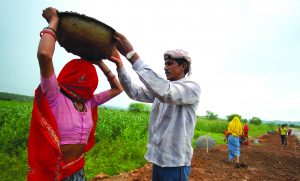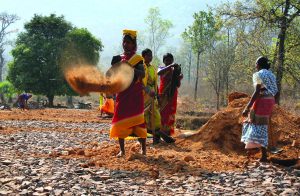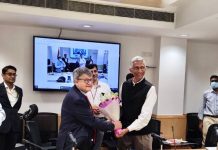 Thanks to low Budget allocation for the Mahatma Gandhi National Rural Employment Guarantee Scheme for the year 2019-20, the government’s flagship programme to alleviate rural poverty by generating employment in rural areas, is gasping for funds.
Thanks to low Budget allocation for the Mahatma Gandhi National Rural Employment Guarantee Scheme for the year 2019-20, the government’s flagship programme to alleviate rural poverty by generating employment in rural areas, is gasping for funds.
During 2019-20, MGNREGS was allocated 60,000 crores. While it was expected that there would be reasonable increase in funds allocation, but actually there was decline in allocation. During 2018-19, the flagship programme of the Union government had got 61,084 crores (revised estimate).
The budgetary allocation for MGNREGS had increased to 61,084 crore in 2018-19 from 34,000 crore in 2014-15. Except for 2014-15, in all years since then, actual expenditure has been more than the approved budgetary allocation. According to the non-profit Centre for Budget and Governance accountability, “The allocations have actually declined when adjusted for inflation.”
Little doubt that the Centre is running out of funds for the MGNREGA scheme because by January 2020, more than 96 per cent of the allocated funds had already been exhausted by the States. Reason the the Mahatma Gandhi National Rural Employment Guarantee Scheme (MGNREGS) had for the first time in five years, been allocated less budget that the previous year’s actual expenditure. In the Budget 2019-20, MGNREGS was allocated 60,000 crores as against 61,084 crores during the previous year.
Since its inception, the actual expenditure has been more than the approved budgetary allocation for this scheme for all states and union territories. For instance for 2011-12, the budget allocation for all states and union territories was 31,000.00 crores but actual expenditure was 37,072.82 crores. Similarly for 2012-13, the allocation was 30,387.00 crores but expenditure was 39,778.29 crores. During 2013-14, the scheme was allocated 33,000.00 crores but expenditure was 38,511.10 crores.
The allocation remained static at 33,000.00 crores for 2014-15 as against expenditure later at 36,025.04 crores. For 2016-17, the budget for this scheme was raised to 48,220.26 crores but
actual expenditure went up to 57,946.72 crores. A year later in 2017-18, the allocation came down to 48,000.00 crores. In 2018-19, budget allocation was raised to 61,084 crores (revised estimates). The expenditure statement is yet not available for these years but the fact that majority of funds have already been exhausted shows that fund crunch has hit the scheme hard.
According to the non-profit Centre for Budget and Governance accountability, “The allocations have actually declined when adjusted for inflation.” The government has to allocate more funds if the Budget provisions are not adequate to meet demand for jobs since this is a demand-driven and legislated programme. It generated 267.96 crore person days during 2018-19.
The overall allocation for the Ministry of Rural Development has increased by 5,200 crores than last year. The total allocation for last financial year, was 1, 17,647 crores, the same as was proposed in the interim budget. In the 2018-19 Budget, it was 1,12,404 crores. But the fact remains that though the allocation for the ministry has been increasing over the years, its share in the total Budget has decreased to 4.4 per cent in 2019-20 from 4.7 per cent in 2018-19.
It is said that at times the figures don’t tell the story. The government had claimed that the allocation of 61,084 crores for MGNREGA was all time high. A release by the Press Information Bureau had claimed that the Government of India had allocated an additional 6,084 crore at the stage of revised estimates to MGNREGA. It had claimed that this brings the total allocation to the scheme to 61,084 crores in 2018-19, making it the highest ever allocation. Governance reforms and thrust on sustainable livelihoods through durable assets has ensured better lives for the poor through wages, incomes and durable assets. The MGNREGA is a flagship programme of the Ministry, which addresses poverty in a holistic manner by overcoming social inequalities and creating a base for sustainable & long term development.
Mahatma Gandhi NREGA is transforming rural India into a more productive, equitable and connected society. It has provided nearly 235 crore person days in the last three years, each year. This year as well, it will be around the same making it four years of consistent high performance on wage employment with durable assets for sustainable livelihoods. The government claimed that over the last four years, the Ministry of Rural Development had completed major reforms in the MGNREGA to transform it into a resource for sustainable livelihoods for the poor. Generation of payments within 15 days was done only in 26.85 per cent cases in 2014-15 and barely 29.44 lakh assets were completed in that year.
A systematic nationwide exercise was initiated for plugging these gaps in partnership with States. Now these sustained efforts have started to show remarkable results. The transformation of MGNREGS can be gauged from the table given below which captures the performance of the programme in 2014-15 and 2017-18/2018-19:
The first and foremost requirement was to ensure full transparency in wage payments, asset creation, and payment for materials. It is for this reason that efforts were started for a 100 per cent of geo-tagging of assets, AADHAAR linking of Bank Accounts, IT/DBT transfers for all wages, and material payments and Geographic Information System (GIS) based planning of works. The intention was that work should be visible in the public domain and beneficiaries receive payments in their verified accounts. As on 08.01.19, GeoMGNREGA is implemented in 31 States/UTs and 3.40 crore works out of 4.08 crore completed works since inception of the programme, are already geo-tagged and are in public domain. Social Audit had a very limited approach and its implementation needed to be extended to the whole country. Social Auditing Standards had to be developed, certified Social Auditors had to be trained, and women Self Help Group (SHG) members had to be brought in for faster roll out.
 On the technical side, while money was being spent on Water Conservation works, the technical training of the staff was inadequate and often many structures were created which did not give the expected outcomes. It is for this reason that the Mission Water Conservation Guideline were drawn up in 2015-16 in partnership with the Ministry of Water Resources, River Development & Ganga Rejuvenation and Department of Land Resources to focus on the dark and grey blocks where the ground water level was falling rapidly. This partnership allowed us to avail the technical knowledge of engineers, scientists from Central Ground Water Board to build a robust technical manual and implement capacity development programme for the frontline workers. A special Barefoot Technicians programme was rolled out to ensure better technical supervision.
On the technical side, while money was being spent on Water Conservation works, the technical training of the staff was inadequate and often many structures were created which did not give the expected outcomes. It is for this reason that the Mission Water Conservation Guideline were drawn up in 2015-16 in partnership with the Ministry of Water Resources, River Development & Ganga Rejuvenation and Department of Land Resources to focus on the dark and grey blocks where the ground water level was falling rapidly. This partnership allowed us to avail the technical knowledge of engineers, scientists from Central Ground Water Board to build a robust technical manual and implement capacity development programme for the frontline workers. A special Barefoot Technicians programme was rolled out to ensure better technical supervision.
There has been a remarkable increasing trend in the budget allocation of the Central Government and release for the programme from 32,977 crores in financial year 2014-15 to 55,167 crores in the financial year 2017-18. This is a clear evidence of the increasing faith of the people in the programme. The MGNREGS witnessed a record expenditure of 63,644 crores in 2017-18 including state share, the highest since the programme was launched. This year is going to be even higher.
The issue of creation of durable assets was very important. The 60:40 ratio was mandated at Gram Panchayat level often leading to non-productive asset being created simply because 60 per cent had to be spent on unskilled wage labour in that Gram Panchayat. Without diluting 60:40 principle, the first big reform was to allow 60:40 at the District level rather than at the Gram Panchayat level. In spite of this reform, the ratio of expenditure on unskilled wage labour to overall expenditure remains higher than 65 per cent. This has enabled a new thrust on durable assets that generate incomes. It allows the flexibility to undertake only those assets that are productive.
Over 60 per cent of the resources are spent on Natural Resource Management (NRM). The NRM works are focused on ensuring higher incomes to farmers by improving both the area under cultivation and yield of crops. This is done by improving the productivity of land and increasing the water availability. The major works taken up under NRM include check dam, ponds, renovation of traditional water bodies, land development, embankment, field bunds, field channels, plantations, contour trenches etc. During the last 4 years 143 lakh hectares of land benefitted through these interventions. Large scale water conservation, river rejuvenation, and irrigation works have been taken up and completed under MGNREGS.
Another major thrust of the last four years has been creation of durable community and individual beneficiary assets. A very large number of Individual Beneficiary Schemes like goat sheds, dairy sheds, 90-95 days work in Pradhan Mantri Awaas Yojana — Gramin (PMAY-G), wells, farm ponds, vermi-compost pits, water soak pits etc. have also been taken up over the last 4 years. These assets have helped the under privileged to have access to alternative sustainable livelihood. Similarly, building of Anganwadi Centers (AWC) has been a significant effort towards creation of durable community assets. The AWCs act as a hub for the care and development of young children where the working mothers can also leave their children behind while they seek work. Nearly 1,11,000 AWCs are being constructed in convergence with MWCD. Solid Waste Management works have also been taken up on a large scale leading to cleaner villages, higher incomes, and more diversified livelihoods for the poor. All this is being possible by permitting 60:40 at the District level rather than at the Gram Panchayat level. The commitment to unskilled wage labour has not declined at all in spite of a thrust on durable assets that are income generating and livelihood diversifying. The following table illustrates the creation of community and individual beneficiary assets under MGNREGS over last 4 years:
The generation of person days each year is a reflection on the thrust for wage labour. Since 2015-16 to 2018-19 so far, the demand for work has been high with average 235 crore person days generation annually in the last 3 years and even this year being no different. These numbers compare very well with almost every year in the past except 2009-10, which was a year of severe drought.
On account of reforms, it was possible to take up pro-poor public infrastructure like Aanganwadi Buildings under the MGNREGS. The linkage of MGNREGS with women SHGs, infrastructure for Deen Dayal Antyodaya Yojana-National Rural Livelihood Mission (DAY-NRLM) activities has also supplemented incomes of very poor households. The skill development opportunities for MGNREGS workers to become certified rural masons, barefoot technicians or in other skill programmes of Deen Dayal Upadhyaya Grameen Kaushalya Yojana (DDU-GKY) and Rural Self Employment Training Institutes (RSETIs) makes a difference to poverty in the long run.
The Ministry intends, in the coming years, to shift the poor from hard physical manual labour to higher forms of livelihoods by equipping them with better skills. Ideally, if the MGNREGA objective of creating sustainable livelihood works well, the number of households depending on MGNREGS should come down. We have on an average five crore households demanding work under MGNREGS each year. Success criteria for MGNREGA could be a reduction in number of households depending on unskilled wage labour. In its provision for work for the disabled and for women, MGNREGS has only improved further in the recent years where more than half the workforce is women and over 4 lakh disabled persons get work every year.
The focus is on the diversification of the livelihoods with multiple sources of income for them to come out of poverty. The expansion of the women Self Help Groups movement under DAY-NRLM from less than three crores to nearly six crores membership has happened during the same period during which MGNREGS was being fully reformed to deliver employment, durable assets and sustainable livelihoods. The generation of payment within 15 days has moved up from 26 percent in 2014-15 to 91 percent in the current, confirming the governance reforms that have made this possible.
The National Evaluation Study of the Natural Resource Management interventions of MGNREGA in 2018 by the Institute of Economic Growth New Delhi, confirmed the gains in incomes, acreage, productivity, water table and fodder availability on account of the NRM works. In that evaluation 99.5 percent assets were found to be very good/good/satisfactory, a proxy for the success of the governance reforms undertaken.
Admittedly there are gains in incomes of individuals but in view of more expenditure in comparison to budget allocation, at least 15 states have negative balance currently. The highest negative balance is in case of Rajasthan at 620 crores, followed by Uttar Pradesh with a negative balance of 323 crores.
Chief Minister Ashok Gehlot has recently written to the Prime Minister Narendra Modi, demanding immediate release of funds to clear outstanding dues of about 2000 crores. The letter mentions that there is an outstanding liability of 848 crores for payment of wages and 1102 crores for materials.
The ambitious MGNREGA could have been the lifeline to revive the rural economy, which is in distress. Indeed, MGNREGA has pushed up rural wages and incomes and has also created rural infrastructure and provided much-needed employment to the country’s rural population. However, it has been unable to provide a stimulus to the rural economy because funds allocation has not kept pace with rising inflation and growing demand because labour migration has come down resulting in more funds to provide guaranteed employment.
FY2014-15 FY 2017-18 / FY 2018-19
Person days generated so far 166.21 cr 236,41 cr
No. of completed work 29.44 lakh 61.9 lakh
Individual Beneficiary Schemes 21.4% 66.7%*
Total Exp. through EFMS 77.35% 99.6%
PAYMENTS generated within 15 days 26.85% 91.82%
*Figures of FY 2018-19
Community and Individual Assets created under MGNREGS
(AS ON 08/01/2019)
SL.NO. Asset Type Completed since 1st April 2014
1 Anganwadi Centre* 37,936
2 Farm Pond 17,37,718
3 Goat Shed 1,12,341
4 Cattle Shed 5,12,398
5 Vermi/Nade[ Composting** 9,99,918
6 Soak Pit** 4,21,941
7 Other Works related to Solid & Waste Management** 4,12,810
8 PMAY (G) & IAY *** 1,36,26,834
* Community Assets
** Community/Individual Assets
*** No. of days for which MGNREGS convergence availed may very per house, up to 90/95 days.











